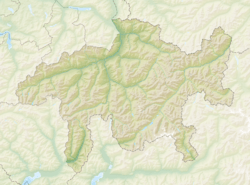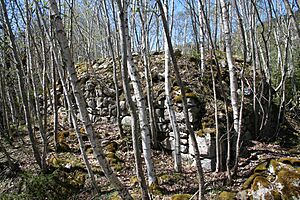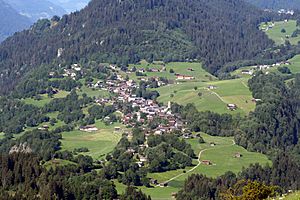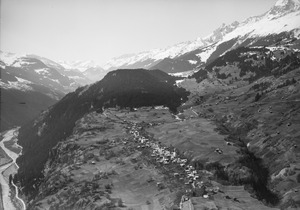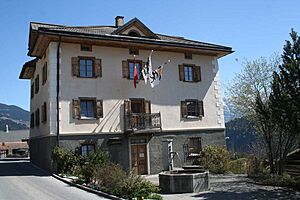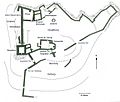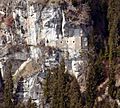Waltensburg/Vuorz facts for kids
Quick facts for kids
Waltensburg/Vuorz
|
||
|---|---|---|
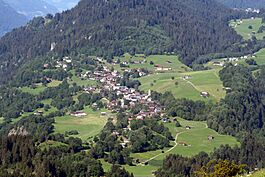 |
||
|
||
| Country | Switzerland | |
| Canton | Graubünden | |
| District | Surselva | |
| Area | ||
| • Total | 32.32 km2 (12.48 sq mi) | |
| Elevation | 1,003 m (3,291 ft) | |
| Population
(December 2020)
|
||
| • Total | 325 | |
| • Density | 10.056/km2 (26.04/sq mi) | |
| Postal code |
7158
|
|
| Surrounded by | Andiast, Breil/Brigels, Linthal (GL), Obersaxen, Rueun | |
Waltensburg/Vuorz was once a small town, called a municipality, in the Surselva Region of the canton of Graubünden in Switzerland. On January 1, 2018, Waltensburg/Vuorz joined with another town called Andiast. Together, they became part of the larger municipality of Breil/Brigels.
Contents
History of Waltensburg/Vuorz
Waltensburg/Vuorz has a long history! It was first mentioned way back in the year 765 with the name Vorce. This name comes from the Romansh language and means "a river fork", which describes where the town is located.
The German name, Waltensburg, appeared later in 1209. It came from an older name for a nearby castle, Waltramsburg. Over time, the castle became known as Jörgenberg, named after a nearby old church dedicated to St. George.
Medieval Castles and Villages
During the Middle Ages, other small settlements like Ladral and Jörgenberg were part of Waltensburg. The area around Waltensburg/Vuorz was home to three other medieval fortresses. These were Grünenfels, Kropfenstein, and Vogelberg. These castles show how important and protected the area was long ago.
In 1734, the people of Waltensburg bought the rights to the Jörgenberg castle area. This meant they gained full control over their land.
Religious Changes and Conflicts
The local church, St. Leodegar, was first mentioned in 1241. For a long time, the area of Andiast was part of Waltensburg's church community. However, things changed in 1526. Waltensburg became the only town in its region to switch to the Reformed faith. This was a big deal because most other towns were still Roman Catholic.
This difference in religion even led to a small conflict in 1682 called the Fahnenkrieg (Flag War). It started when Catholics from Andiast walked through Waltensburg on their way to Rueun.
Modern Times and Population Changes
For many years, until 1963, Waltensburg was financially stable. It earned money from using its water and forests, so it didn't need to collect property taxes from its residents.
However, in the 1960s, many small farms started to combine into bigger ones. This caused many farmers to move away to larger towns like Ilanz, Domat/Ems, and Chur to find work. But in recent years, as tourism has grown in Romansh villages, some people have started to move back to places like Waltensburg/Vuorz.
What Does the Coat of Arms Mean?
The blazon (description) of Waltensburg/Vuorz's coat of arms shows a brave scene. It features St. George dressed in blue armor with a red and gold cape. He has a halo around his head and is riding a black horse. St. George is shown killing a green dragon with his lance.
This image is important because St. George is the patron saint of the local church. The castle, Burg Jörgenberg, was also named after him.
Geography and Nature
Waltensburg/Vuorz is a "linear village," meaning its buildings are spread out along a line. It sits on a high flat area, about 1,008 meters (3,307 feet) above sea level. This area is north of the Vorderrhein river, about 250 meters (820 feet) higher than the river itself. Until 1943, the town was simply known as Waltensburg.
The total area of Waltensburg/Vuorz is about 32.3 square kilometers (12.5 square miles). This land includes areas on both sides of the Vorderrhein river. It also stretches up to the top of the Ruchi mountain, which is 3,107 meters (10,194 feet) high. This mountain is on the border with the canton of Glarus.
Land Use in Waltensburg/Vuorz
- Farmland: About 36.5% of the area is used for farming.
- Forests: Around 22% of the land is covered by forests.
- Buildings and Roads: Only about 1.5% of the area has buildings or roads.
- Natural Areas: The remaining 39.9% is made up of rivers, glaciers, or mountains, which are not used for farming or building.
People and Population
Waltensburg/Vuorz has a population of 361 people (as of 2022). In 2008, about 4.7% of the people living there were from other countries. Over the last ten years, the number of people living in Waltensburg/Vuorz has gone down by about 11.9%.
Languages Spoken
Most people in Waltensburg/Vuorz speak Romansh, which is 63.4% of the population. The second most common language is German, spoken by 32.4% of the people. A small number of people, 1.3%, speak Dutch.
Age Groups in Waltensburg/Vuorz (2000)
- Children (0-9 years): 14.1%
- Teenagers (10-19 years): 14.9%
- Young Adults (20-29 years): 8.4%
- Adults (30-59 years): 36.3%
- Seniors (60-99 years): 26.3%
Education and Jobs
Most adults in Waltensburg/Vuorz (about 75.7% of those aged 25 to 64) have completed high school or gone on to higher education like university.
The unemployment rate in Waltensburg/Vuorz is very low, at only 0.6%. This means almost everyone who wants a job has one.
Here's how people are employed in different types of jobs (as of 2005):
- Primary Sector (Farming, forestry): 46 people work in this area, with 19 businesses.
- Secondary Sector (Manufacturing, construction): 4 people work here, with 2 businesses.
- Tertiary Sector (Services like tourism, shops): 58 people work in this sector, with 16 businesses.
Population Over Time
The table below shows how the population of Waltensburg/Vuorz has changed over many years:
| Year | Population |
|---|---|
| 1850 | 443 |
| 1900 | 362 |
| 1930 | 394 |
| 1950 | 406 |
| 1990 | 349 |
| 2000 | 383 |
| 2010 | 364 |
Important Historical Sites
Several places in Waltensburg/Vuorz are considered very important historical sites in Switzerland. These include:
- The Swiss Reformed Church of Waltensburg/Vuorz, which has beautiful old frescoes (wall paintings).
- The ancient settlement and medieval castle at Jörgenberg.
- The Richtstätte / Galgen Fuortgas (an old execution site).
- The ruins of Kropfenstein Castle.
Discoveries at Jörgenberg
Archaeologists have dug up many interesting things at Jörgenberg. They found signs of a settlement from the Bronze Age and another from the Iron Age (when the Raetia people lived there). They also found some items from the Roman Empire.
The Church of St. Leodegar
The Reformed parish church of St. Leodegar was first mentioned in 1241. The amazing frescoes inside the church were painted by an unknown artist, sometimes called the Waltensburg Master. These paintings were created between 1350 and 1450.
Images for kids
-
Fresco of the Stations of the Cross
See also
 In Spanish: Waltensburg/Vuorz para niños
In Spanish: Waltensburg/Vuorz para niños




